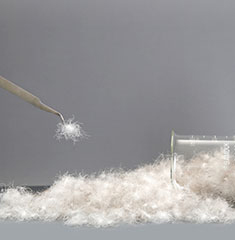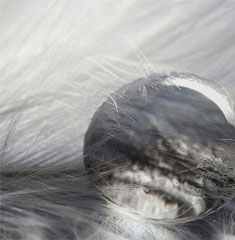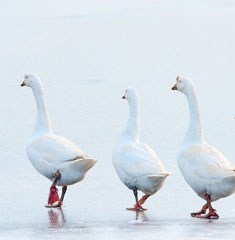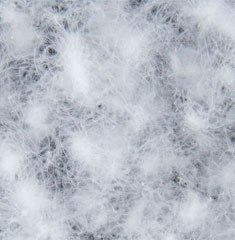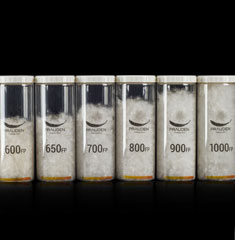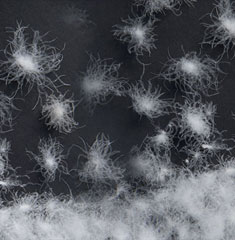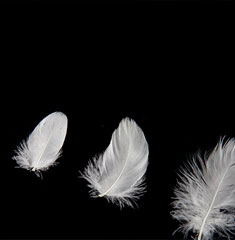
Down Quality Determining Factor 7. Odor
2019-08-21
At PRAUDEN, we inform consumers of the important factors that determine the quality of down via feature articles so that they can make informed decisions when purchasing down. Following on from ‘turbidity’ in the last issue, we will finally look at ‘odor’ as a factor for determining down quality.
See Down Quality Determining Factor 1. Content
See Down Quality Determining Factor 2. Fill Power
See Down Quality Determining Factor 3. Species Identification
See Down Quality Determining Factor 4. Black Point
See Down Quality Determining Factor 5. Oil & Fat
See Down Quality Determining Factor 6. Turbidity
What is the Odor Test?
This is a test to check for the presence of unpleasant odors, such as peculiar smells of down, mold and chemicals. The main ingredient of the down is the animal protein keratin. Due to the fat and oil in the rearing process, feathers can have a peculiar smell. Proper cleaning using the appropriate chemicals during processing will minimize odors.
What factors affect odor occurrence?
–Aequornithes Rearing Method: When grazing in their natural state, there are less oil and fat and less odor than when mass rearing.
–Down Processing Method: The extent of odor depends on the cleaning time and the type and amount of chemicals used during down processing.
–Drying Time After Washing Down: Odor occurs if the down takes a long time to dry completely.
–Down Storage Method: Odor occurs if down is stored in a high-humidity environment.
Odor Test Method (according to KS K 0820)
1. Sampling (same as other tests)
2. Test Methods
1) A sample is put in an Erlenmeyer flask and 50mL of distilled water is added and mixed until the sample is sufficiently wet.
2) The lid is left closed for 24 hours in an air circulation oven at 37.8℃ to 40.6℃, and then the lid is opened to evaluate the presence of odor.
3. Evaluation
1) There should be no unpleasant odors such as strong smell, chemical smell or mold smell.
2) If five testers detect an unpleasant odor after smelling, the down fails the test.
What should I do if I detect an odor from down?
Odor may occur during production and use of down products. In most cases, the smell is temporary due to handling problems, so it is recommended to know the proper handling and treatment measures.
Q1. There is an odor coming from down stocked in the sewing factory that was transported by sea.
A1. During sea transport in containers, down can be exposed to high temperatures and high-humidity environments, which can increase the moisture content of the down, resulting in odors. Using pallets, etc. to keep the down off the floor and storing in a shaded area with good ventilation for several days can rid the down of moisture and odor.
 <Down may be affected by temperature and humidity when moving the container.>
<Down may be affected by temperature and humidity when moving the container.>
Q2. When attempting sewing work after storing down in the factory, there is an odor.
A2. Odor may occur if the down storage environment in the factory is not appropriate. The down storage area should be naturally or mechanically well-ventilated. Keep room temperature below 30℃ and relative humidity below 70%. Keep out of direct sunlight and maintain luminance below 500LUX. If odor has already occurred due to storage problems, store it in an appropriate place such as in A1.
 <How to Store Down>
<How to Store Down>
Q3. The consumer has complained about odor after purchasing the product.
A3. There are many causes of odor after consumer purchase, but it is usually down to one of the following reasons.
① If the product absorbs sweat: The smell of sweat and down can combine to produce an unpleasant odor. If the odor does not disappear after drying, wash and dry using the correct methods.
② If the product is stored for a long time in an unventilated area: Drying in a well-ventilated place will remove the odor.
③ If the product is not completely dry after washing: Even though the down is bulky and seemingly dry on the outside, the inside of the down is often wet, clumped or contains moisture. If you dry the down completely throughout the inside using a dryer or a fan, odor will disappear. You can also break up clumps of down by patting them with your hands or a towel.
In the above case, it is not a problem with the down itself but a temporary phenomenon caused by external factors. However, there are cases where odors caused by improper collection, pre-washing and washing of down do not disappear completely even after additional washing. Harmful microorganisms, mold, and detergent residues may remain and require accurate diagnosis by a specialist.
To learn more about the proper handling of down, refer to PRAUDEN’s Down Processing Manual.
By Oh Joon-jae, R&D Part, PRAUDEN






